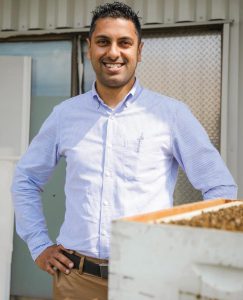New bee sanctuary provides space for insects to thrive
From their intricate social structure and astonishing navigation abilities to their indispensable role as pollinators, bees are the unsung heroes that quietly work to sustain our ecosystems.
For College of Engineering, Architecture and Technology research professor Dr. Imraan Faruque, they could provide a wealth of information as it pertains to the rapidly growing area of robotics.

Dr. Imraan Faruque
In 2019, Oklahoma State University researchers set up an experimental camera apparatus that would allow them to measure large groups of bees.
“We have both a wide-area, lower-speed system that covers a wider area and it gives us that sort of less detailed measurement,” said Faruque, an assistant professor of mechanical and aerospace engineering. “Then, we have the high-speed system that usually is looking at a handful of insects rather than dozens of insects and that’s what’s allowing us to zoom in on those detailed areas.”
After just five years of studying these tiny creatures, Faruque has made significant developments in understanding bee communication patterns. For example, Faruque and his graduate assistant, Saiful Islam, made an insightful discovery of the efficiency of bee reaction times.
These researchers developed a new experiment where honeybees chased a motorized hive entrance. The reaction time between bees became increasingly more uniform when they were in a group as opposed to being alone. One theoretical explanation is the change helps them maintain swarm cohesion, and that possibility has started a new discussion in the research community.
Faruque’s research has evolved beyond swarm measurements and has begun focusing on individual bees at a higher speed.
“That is what gives you a key into their neural function, beyond the sort of input-output relationship,” Faruque said. “It’s the difference between seeing a vehicle navigate and inferring what the driver did with their controls vs. actually seeing those controls.”
But why is this research so important? How does studying bees contribute to robotics in engineering?
By understanding and emulating the coordination and communication abilities of bees, researchers can enhance a robot’s capabilities for search and rescue missions or environmental monitoring.
For instance, drones can communicate with each other by exchanging information about their locations, obstacles, or targets without human intervention by using advanced algorithms. However, developing those advanced algorithms and a deeper understanding of the physics and mechanics behind swarming techniques are unique challenges that Faruque and his team must overcome.
“Going from experiments backward is what we call system identification,” Faruque said. “It’s where you have the inputs and outputs, but you don’t know what the physics are, or you don’t know what the function is that relates them, and you need to figure out what that is.”
While studying bee swarming is helping to develop unmanned robotics, there is a secondary impact of this research project at OSU. Faruque has partnered with OSU Facilities Management to create a bee sanctuary in the new campus pocket prairie. Not only will this allow researchers to study bees outside of confinement, but it will also directly impact our local and worldwide environments.
Bees play one of the most important roles in our agriculture and food-sourcing pollination. The process of transferring pollen from male flower parts to female flower parts leads to fertilization and the production of fruits, vegetables and seeds. Approximately 75% of the world’s leading food crops depend on pollinators like bees. The loss of bees would result in fewer flowers being pollinated and, consequently, fewer fruits and seeds being produced, leading to a decline in overall food production.
In communities with low bee populations, farmers have been forced into the fields to individually pollinate every flower with a paintbrush. Faruque said.
“It’s to the point where some crops need to be manually pollinated, which means there is a person out there with a tiny brush that is going from flower to flower hand brushing.” he said. “We have talked about doing this with a drone, but the primary focus would be to see if we can recover that honeybee pollination capability. That’s why we are starting to look at native pollinator gardens.”
The loss of bees would have a severe impact on our food sources, leading to decreased crop yields, reduced food diversity and potential ecological imbalances. Protecting and preserving bee populations is crucial, which is exactly what this OSU engineering team is attempting to achieve with this new bee sanctuary. This sanctuary will be blooming with flowers and provide the perfect home for a brand-new colony of bees.
Since 1962, the bee population has been steadily declining with the potential to go extinct. The loss of bees would mean a loss in all that they provide. Efforts to restore bee colonies are paramount to the survival of these amazing marvels of the insect world and to the various impacts they have on our lives.
“Honeybees are the backbone of our pollination strategy,” Faruque said, “And just looking at how they are choosing to forage in the new sanctuary will help to inform that societal food insecurity issue.”
Media Contact: Kristi Wheeler | Manager, CEAT Marketing and Communications | 405-744-5831 | kristi.wheeler@okstate.edu
Photos: Alyssa Williams
Story by: Alyssa Williams | IMPACT Magazine
We are here to share current happenings in the bee industry. Bee Culture gathers and shares articles published by outside sources. For more information about this specific article, please visit the original publish source: https://news.okstate.edu/magazines/engineering-architecture-technology/impact/articles/2023/new_bee_sanctuary_provides_space_for_insects_to_thrive.html






